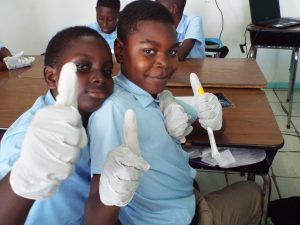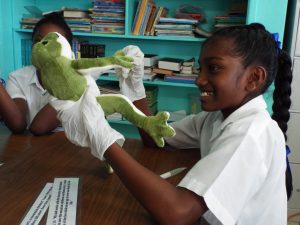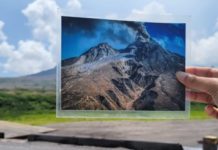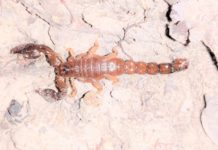What could be more important than engaging young children in the wonderfully wild world around them, opening their eyes to new careers, opportunities and even dreams!? Well this was exactly how we started our week on the project and it was fantastic!
We visited the 6th grade class at St. Augustines Primary School for an afternoon filled with activities especially designed to excite and engross them in, you’ve probably guessed it already, everything weird and wonderful about the mountain chicken!
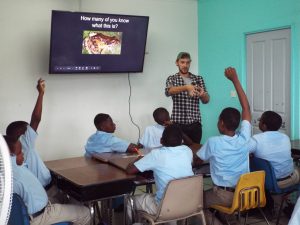
It’s a strange thing to think that so many of these children have never even heard a mountain chicken let alone see one. Being born just before the introduction of chytrid back in 2009, and the consequent rapid decline of the species, these children most likely represent the first generation on Montserrat to have grown up with little to no interactions with the mountain chicken. As such outreach activities like this are so important not only to educate and excite them in wildlife and its conservation, but also to bring them closer to the natural and cultural heritage of their island that makes it so unique on a world stage.
We began with a simple activity to set the scene; sitting in the classroom, all eyes closed and fingers drumming lightly on table tops to mimic rain, the children imagined they were walking through the forest at night. Gradually they were introduced to the sounds of the forest they know, crickets chirping, tree frogs calling and then a sound none of them recognised… a mountain chicken!! All eyes snapped open in shock and wonder and we progressed onto the next activity (click the link below to hear it for yourself).
Working together in a team the class had to piece together all the of the different factors that could have contributed to the mountain chickens decline on the island. They looked at how the relationship of the islanders and their giant frog had changed over the years, how the volcanic eruption reduced their habitat and range and finally they were presented with a difficult dilemma… a pond filled with dead mountain chickens, yet the cane toads and tree frogs in the area all seemed unharmed.
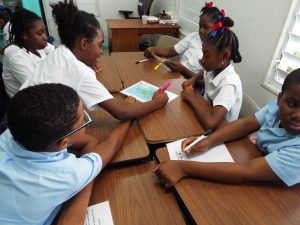
The time had come for our investigators to become scientists! Empowered with the knowledge they had collected and discussed as a team they decided they would needed to run tests on the cane toads and dead mountain chickens in order to try and determine what had happened that could have caused the deaths of just the mountain chickens. They reasoned that the mountain chickens had survived generations of hunting and seemed to have a healthy population in the north even after the volcanic eruption so something else must be at play! Luckily for them I had come prepared for just such a situation!
Our little scientists, equipped with plastic gloves and swabs were taught the proper handling and swabbing techniques and protocol and set to work taking samples from toy mountain chickens. Some were even brave enough to help swab a real cane toad we had caught the night before!
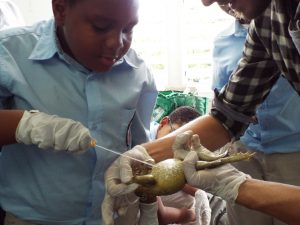 Once the swabbing was complete the children submitted their swabs for analysis and eagerly awaited their results. Unfortunately the news was dire… we had detected chytrid on all of the swab samples. This lead us nicely into researching and discussing why only the mountain chickens had been affected by the fungus as well as the current measures we are taking as part of the Mountain Chicken Recovery Programme to help control the fungus and reintroduce them later next year.
Once the swabbing was complete the children submitted their swabs for analysis and eagerly awaited their results. Unfortunately the news was dire… we had detected chytrid on all of the swab samples. This lead us nicely into researching and discussing why only the mountain chickens had been affected by the fungus as well as the current measures we are taking as part of the Mountain Chicken Recovery Programme to help control the fungus and reintroduce them later next year.
The day concluded with lots of eager questions and plans for how they could come out to visit us in the field. Later this year the children will be joining us to conduct more scientific studies in the field, which will also contribute to their final year report on the mountain chicken.
